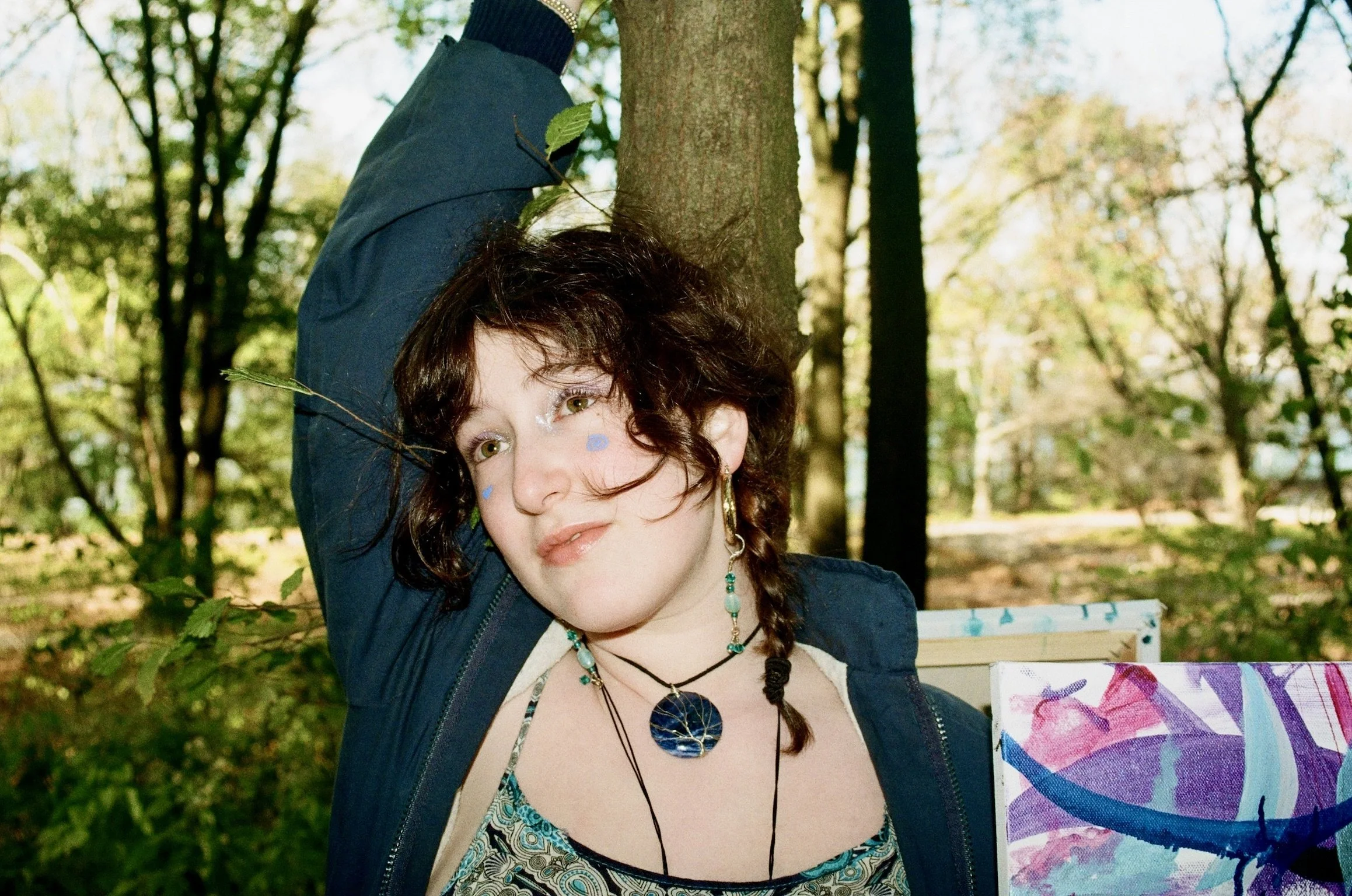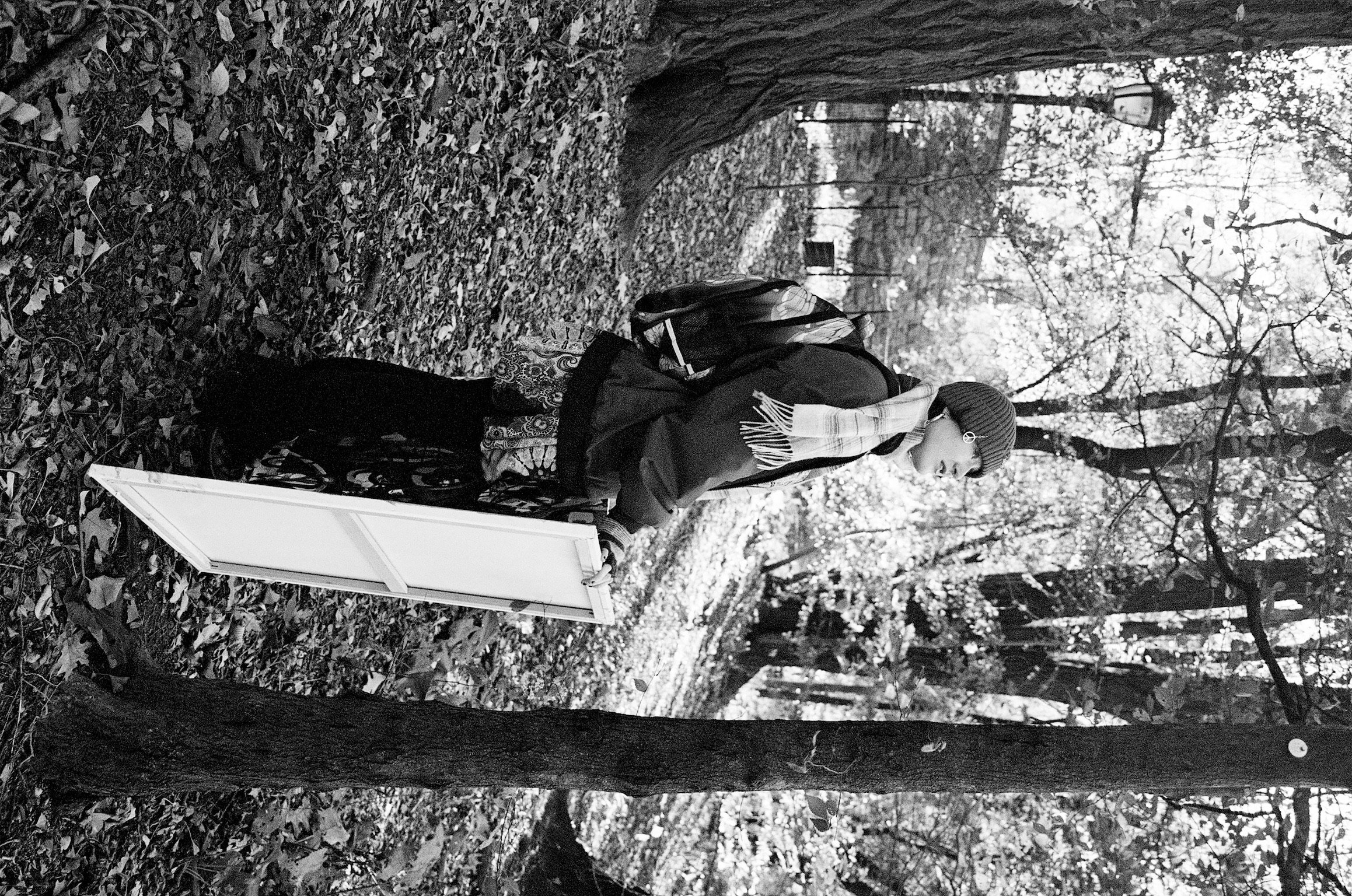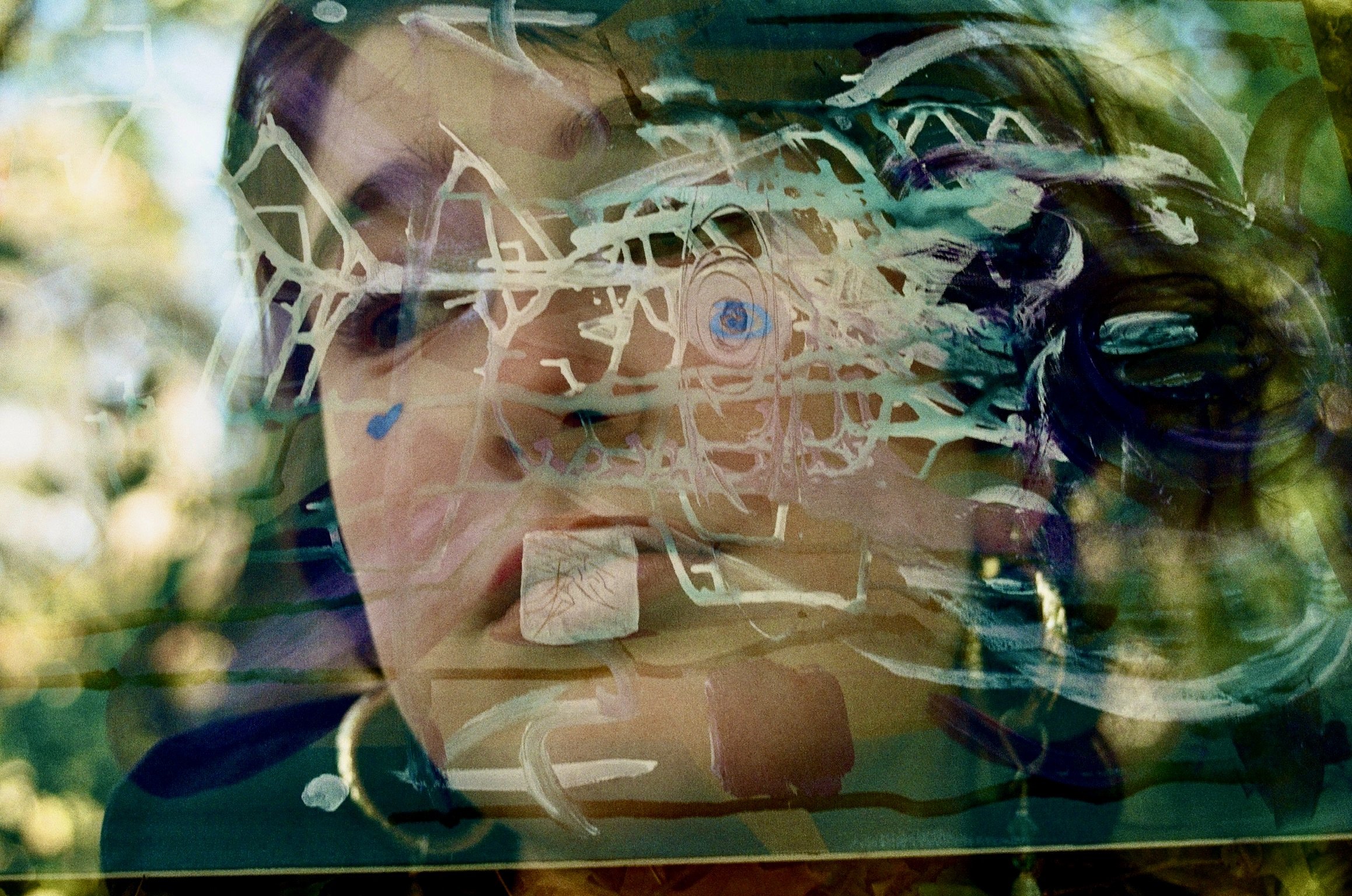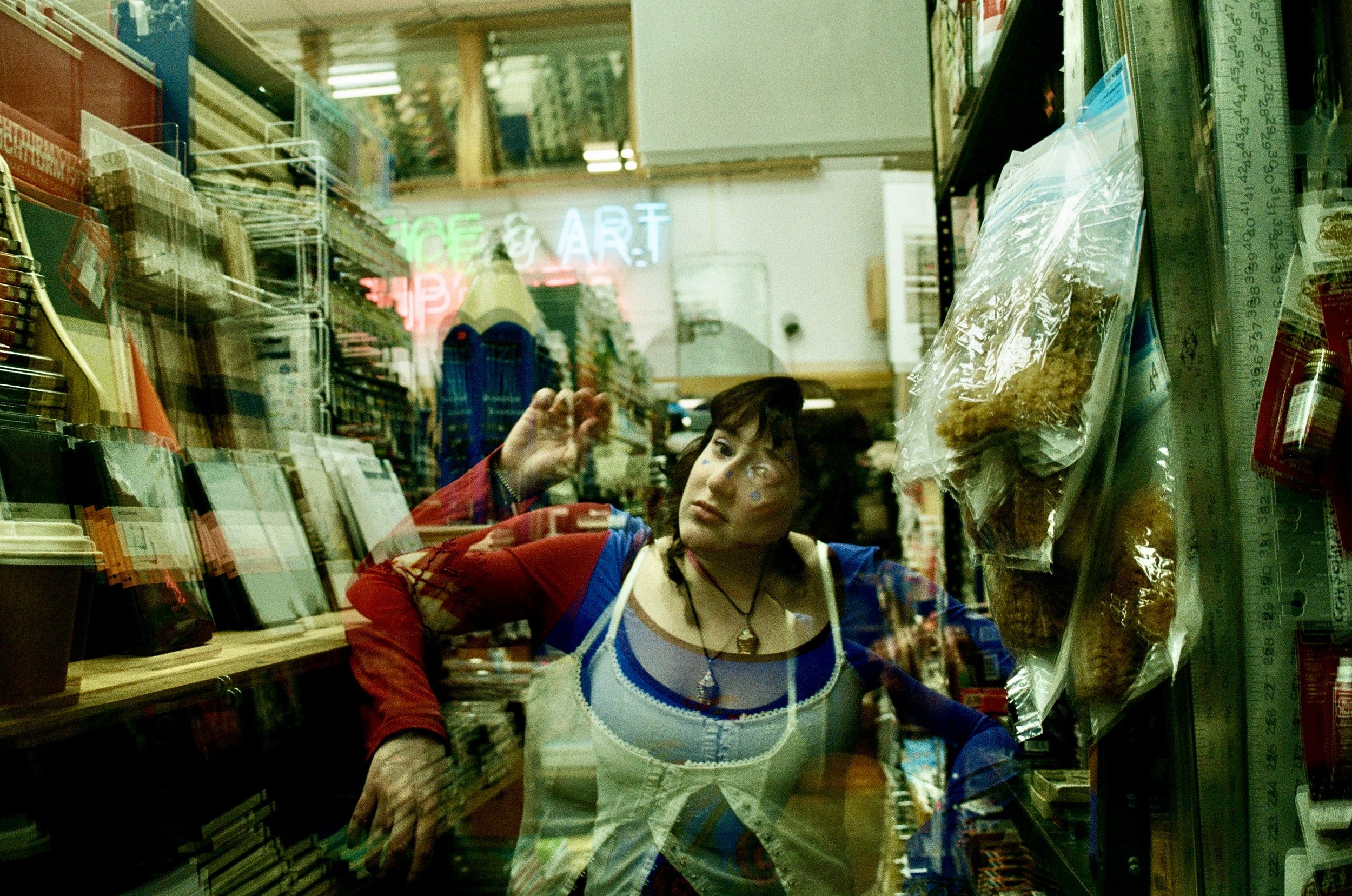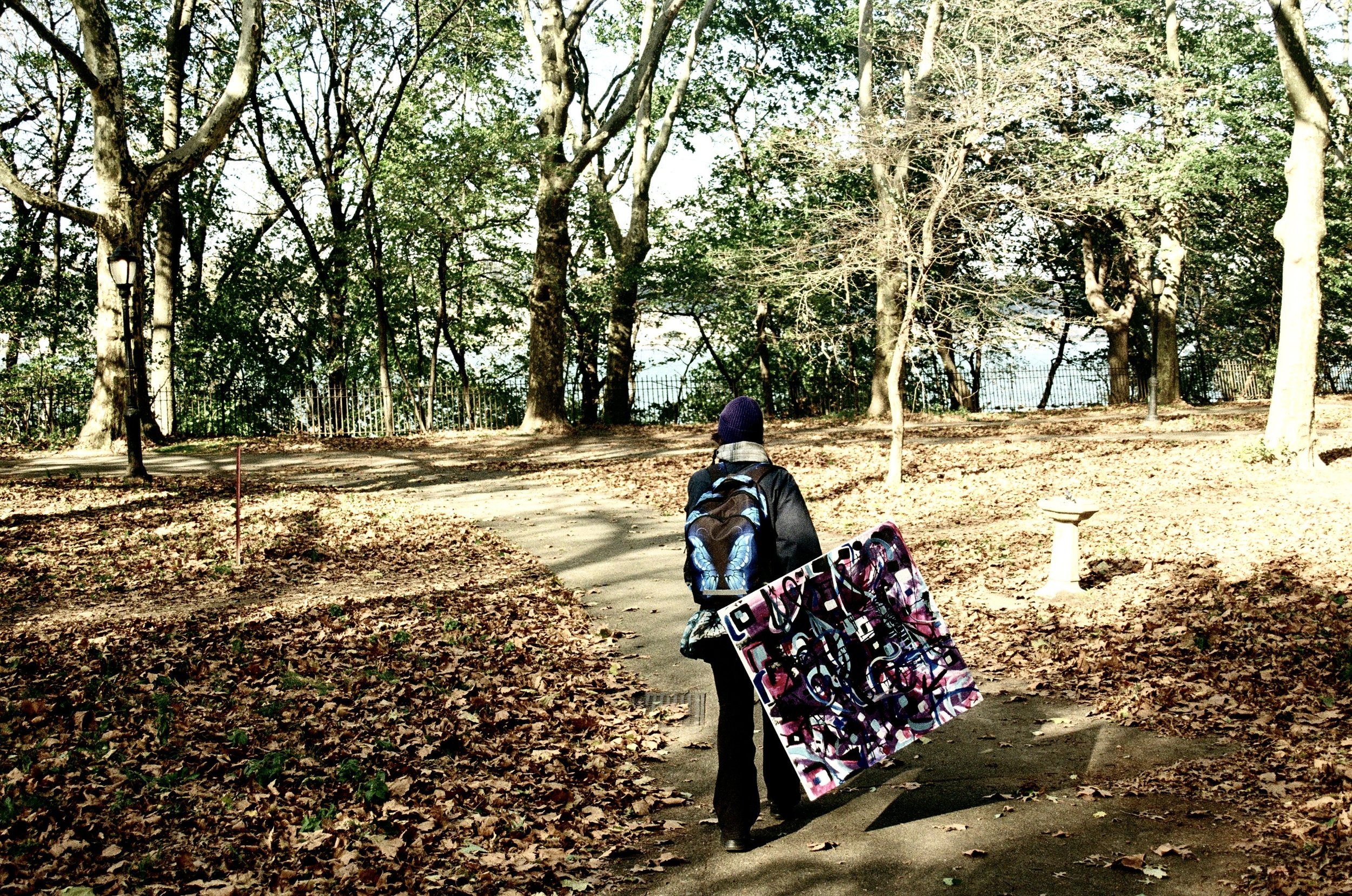Feature by Sahai John
Photos by Orla Meehan
Local New Yorker Penny Shapiro is a freshman at Barnard College. With spiral motifs and abstract images, Penny contextualizes abstraction by connecting her multimedia works of art to ruminations on nature, self-worth, and the world around us.
Your work is a mix of acrylic, ink, pen, and pastel. What is your process of layering these materials?
The process starts at an art store. I choose the colors that I naturally gravitate towards and the materials that I feel inspired by. Ink is something that has been an important part of my recent works.
Untitled #18
I start by putting anything on the canvas. Part of the reason why I love making art is because it is freeing. I'm a very plan-oriented person, yet creating art is the one time I am capable of letting go of all expectations. A piece is not finished until I truly feel it's finished. Every work requires a lot of layering. It all just begins with a stroke, then a pouring of ink, then moving the canvas up and down, letting the ink naturally fall in place. Then comes adding shapes, patterns, more strokes and color.
Every piece takes a different amount of time. I sometimes make pieces in one night. Sometimes I feel the need to spend weeks returning to it over and over again. Some pieces I work only with bigger gestures, and others with smaller details as well—it all really depends. Though I do think that, despite not planning, the more I create, the more I find a consistent rhythm.
My paintings all look like things I have made and I’m proud of that.
You present many repeating patterns, like the spirals that come up in many of your works. What is your connection to spirals?
It's my trademark. It began when I first started drawing. My mom had said that she used to draw spirals all over her notebook and I thought, ‘That's so cool!’ I felt so inspired. I was initially drawn to the pattern aesthetically, then as I thought about it more philosophically and I became fascinated by the fact that spirals exist everywhere in nature: snails, seashells, whirlpools, DNA double helix, the galaxy, the fibonacci spiral, our fingertips. So many spirals!
Rendered Skirt
THE PANTS and MADELEINE
I took this environmental history class in high school and it made me think about cyclical patterns and how nature can be so regenerative. Cyclical patterns are inherent to the natural world, yet modern society tends to be so linear. These “linear” systems, such as industrialism, consumerism, and extreme capitalist ideologies are proven to be not sustainable for life at all. They are hurting us so much. It's upsetting to me how Western societies have bent over backwards, trying to control and implement these linear systems rather than mirror society according to nature’s intrinsic patterns.
These are things I think deeply about. And I want my work to be a reflection of my contemplations—What can we do better? How can we rethink our relationship to nature and each other moving forward? How can my art inspire circularity?
You’ve talked about journaling as a way of conceptualizing your art. Is that how you develop meaning to your work?
This is a process that I usually do for my sketchbook works. I'll create them while watching TV, listening to music, or riding the bus, generally while doing more mundane activities. These works are even less thought out than my paintings, so I love to journal after I make them in order to contextualize their abstractions. And honestly, sometimes these journal entries aren’t even that deep. They could be about the simplest experiences from that day, the small things, the big things I've been thinking about in the world, things I've been learning in classes, or the things I’ve discussed in conversation with friends.
New Sketchbook Work #1
To provide context for what I'm thinking about at the time of creation helps me process my own work. Thinking about the world and our existence is what influences the abstractions.
Are you thinking about the placement of everything in your artwork and how it conveys a specific meaning?
It really depends. I do believe that I think aesthetically when I paint, yet the process is still very organic.
Skeleton to the Spiral Tower
This piece, Skeleton to the Spiral Tower, is supposed to be a representation of my thoughts regarding spirals and these linear ways of structuring society. I did not intend for this section of white ink to look like a skeleton but when I contemplated it after, it was exactly what I saw. It reminds me of the lack of care for life, and how so many corporations and politicians prioritize monetary gain over the wellbeing of all humans. I started to think about the relationship between the skeleton and the spiral in the middle, and only after creating this piece did I realize that it is an anecdote to human’s destructive relationship to nature.
What is your connection to self-portraiture? How do you want viewers of your work to see you?
I don't know if there's one specific way I want a viewer to see me, but I do think taking photos of yourself can be empowering. Self-portraiture can be empowering, to be able to have the confidence to put your own face in a piece! I feel powerful using my own body as a medium. I could take a photo of myself at any point in time to make something right away. I'm right here.
The Puzzle Piece
When did you start doing photography and what is your connection to it?
My interest in art actually started with photography. During middle school and the beginning of high school, I took a variety of photography courses. My main passions used to be about fashion photography, but I didn't feel like I could fully communicate my voice through this medium. So at that time I found painting and drawing to be more fulfilling. After a few years, I returned to photography after engaging more with new mediums.
Light Painting #7
I found that I really love making light paintings. I made almost all of my light paintings while dancing in my room with a flashlight. The camera captures all the movements of the light. It’s a really fun way of combining photography with dance. These works capture a lot of what my abstract paintings also capture. There's a similar aesthetic to them, which I think is awesome. Finding my voice through painting and drawing is how I found photography again, and I realized that I could use that medium to do the same.
What connection does dance have with your artwork?
Painting is physical. Making a painting is somewhat like making a dance. There is a physicality to putting paint brush to canvas and my work is very gestural.
THE TIME CAPSULE OF MY MIND Film and Clip of Performance
This film, which is called The Time Capsule of My Mind, was created for my high school’s program, Choreolab. In 12th grade, I choreographed The Time Capsule of My Mind which was a combination of film and live performance. The film was projected onto the back of the screen in my school’s theater. Then, once the film finished, there was a transition between this projection and my dancers dancing on stage. To create that film, I utilized the light and acrylic paintings I had made in the past. I wanted the film’s aesthetics to mesh well with my painting and photographic style.
In the film, which is a combination of choreography, cinematography, painting, and photography, the connections between the way I paint, the way I move and film are apparent. These connections are something I want to think more deeply about and continue to explore.
I also want to perform and curate performances more often. I really love the idea of choreographing for the group CoLab here at Barnard! It is a dance group that holds performances in the movement lab. It is a really inspiring space because there's so much you can do with lighting and projection. It would be a really great space to find connections between visual art and dance.
A lot of your work feels like an expression of yourself and a way for you to show yourself on paper, a canvas, or screen.
It is an expression of myself and my thoughts, and the way I perceive the world around me. It's a way to get all of the language onto a canvas and to create something tangible that I can see and process in a different way than through words.
2022 Self-Portrait
Do you feel like your art has shown the way you've grown?
My art totally is a reflection of how I've grown. You can see it since the beginning of my work. It definitely has changed. The earlier works are so much smaller, but now I'm working on 24 inch by 36 inch canvases. You can definitely see how I've evolved as a human being and artist.
Gather From Everywhere Part 2
I've learned to trust myself. I felt like an imposter when I first started making art, and didn't want to label myself as an artist. I didn’t even think that I was making what could be considered art. But the more I create, and the more work I accumulate, the more passionately I associate with that title “artist”.
Do you feel like by validating your art, that serves as validation for yourself?
I've gained a lot of confidence over time in my work and then in myself too. Owning it. This is what I love to do. This is my art whether you think it's good or not. I don't care. I love making it.
Untitled #19
Release
Where do you hope to go with your art in the future?
I don't know yet, but I will always be making it. All I want to do is continue creating and sharing it. I would love to be in a gallery, have a solo show, or curate an exhibition of my own. The dream is to actually pursue art as a career. But regardless of where I end up, art will always be my pursuit, and I will share it with the world no matter the platform, because I never want to stop. I can’t stop!
Where can we find your work?
On my Instagram: @byp3nny, and on my website: https://pennyshapiro27.wixsite.com/my-art































